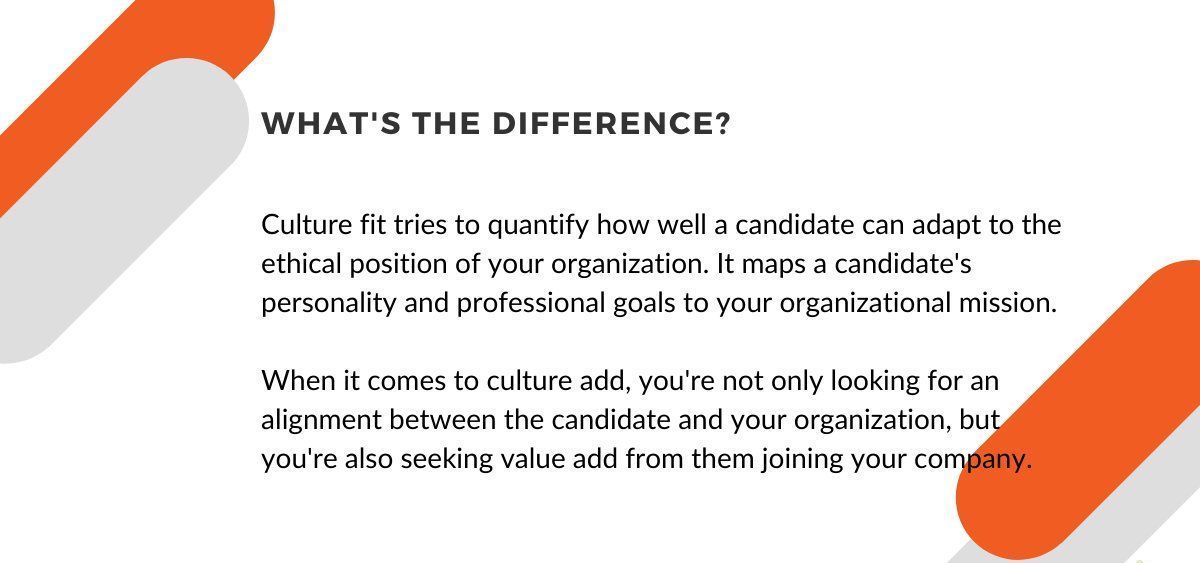Culture Fit Or Culture Add?
What criteria should you consider when hiring? Should you aim for culture fit or culture add? Or both?
Culture fit refers to aligning a candidate's values, beliefs, attitudes, and behaviour with your company's. When "hiring for culture fit," you want to assess how well the candidate will adapt to accomplishing things around your workplace. Does the candidate share the same core values and mindset, and will they adhere to your company’s mission? Companies hire for culture fit mainly because of team cohesion, retention and engagement, organisational values, and adaptability.

Team Cohesion
Employees who share similar values feel more at home in an organisation. Working well together as a team increases well-being and productivity.
Retention And Engagement
Employees who feel strongly connected to your company's culture are more energetic and dedicated. They will feel motivated, and their work performance will often surpass what is expected of them. With satisfied employees, there will be less turnover and thus reduced expense on backfilling.
Organisational Values
If the way results are achieved must align with your organisation's values, hiring for culture fit helps ensure that new hires adhere to and behave in a way associated with them.
Adaptability
Companies with a strong culture often seek individuals who can adapt to and thrive in such a work environment. Hiring for culture fit can help identify candidates more likely to adjust well to the company's norms, processes, and expectations.
When Culture Fit Matters
Hiring for culture fit is particularly relevant in organisations where culture significantly shapes the work environment and employee experience. Startups, nonprofits and social enterprises, customer-centric companies, and companies with unique cultures can significantly benefit from focusing on culture fit.
Startups
Especially during the early stages, startups often need passionate employees capable of keeping up with a fast-paced work environment. They specifically select candidates who demonstrate an entrepreneurial mindset and a willingness to take risks.
Nonprofits And Social Enterprises
These organisations seek employees who want to work towards the same goals, focusing on a social impact, such as helping society or the environment.
Customer-Centric Companies
When delivering excellent customer experiences is essential for your company’s profitability, finding employees with a strong customer focus is vital.
Companies With Unique Cultures
Certain companies have established a distinctive work style and philosophy that set them apart. This phenomenon is often found in creative agencies or tech startups. Hiring for culture fit helps preserve the unique character and identity of the organisation. In some instances, it can be crucial to maintain efficiency.
Thinking Outside The Box - Culture
Add
While culture fit focuses on aligning an individual's values with your company culture, culture add emphasises diversity and hiring employees with different perspectives and backgrounds.
The idea is that those people can enhance and enrich your existing culture, challenge the ways things are done, and help your current team think outside the box.
Diversity can refer to ethnicity, gender, age, sexual orientation, educational background, disability, neurodiversity, and personality. People of diverse backgrounds have different needs and perspectives.
By consciously considering culture add, organisations can foster innovation and better adapt to evolving needs and challenges. It can be appropriate for organisations looking to improve diversity and inclusion for better decision-making, innovate and close knowledge gaps, transform culturally, and expand to new markets.
Diversity And Inclusion For Better Decision-Making
Seeking candidates with different backgrounds and perspectives brings in a range of experiences and viewpoints. When individuals with complementary strengths work together, they will approach decision-making more holistically. This will eventually lead to more balanced decisions.
Innovating And Closing Knowledge Gaps
Innovative companies who aim to disrupt traditional markets need fresh perspectives and out-of-the-box thinking. Hiring individuals with unconventional ideas, diverse skill sets, and a willingness to challenge established norms can drive innovation and change, two traits needed to stay ahead of competitors.
Cultural Transformation
When your company undergoes a cultural transformation, bringing in individuals who embody the desired culture can contribute to accelerating and improving the change process. New hires with different experiences or skills can complement your team's capabilities.
For example, if your company operates mainly onsite but now wishes to embrace a remote-first culture, it can benefit from hiring new team members who have worked in distributed companies in the past and thus can help define best practices and establish new processes.
Expanding To New Markets
When expanding into new markets, you must understand your new customers thoroughly. Some marketing strategies work well with one audience rather than with another. Product names may sound funny in the local language. To fully understand your new market, hire employees from your target group. You’ll soon see the value.
Balance Culture Fit And Culture Add
While culture fit and culture add are distinct approaches, they need not be mutually exclusive.
Organisations need to adapt to the needs of customers and markets and the availability of new employees. For example, a creative agency hiring only 30-year-old hipsters may need help finding employees matching their specific candidate persona. Daring to make more diverse hires may be crucial to the company’s growth in such a case. A team can be diverse but still aligned with the company’s goals.
While the company's DNA should remain intact, diverse perspectives can bring innovation and fresh ideas. Finding the right balance is critical to creating a well-rounded workforce.
High Performer Versus High Potential? Picking The Right Hire
Should organisations go for high performers who demand a higher salary or opt for high potentials at a lower cost? It's like choosing between instant gratification and long-term growth.
High Performers: The Masters Of Now
High performers serve as the rock stars of the workplace. They consistently deliver exceptional results and boast a stellar track record. These people bring top-notch skills, valuable experience, and a drive to greatness. They may hold high compensation desires, but high performers are your go-to team members when you need something done quickly and flawlessly.
High performers often reach their peak productivity early on and need help to improve significantly beyond that point. They may resist change, have difficulty learning new skills, or struggle to adapt to evolving technologies. While they’re great at their work, their growth potential may be limited.
High Potentials: Unleashing The Future
On the flip side, high potentials are like diamonds in the rough. They may lack extensive experience but possess an insatiable hunger for growth and plenty of untapped potential. These eager learners can quickly adapt to new challenges and acquire new skills.
One significant advantage of high potentials is their ability to thrive in dynamic environments. They bring fresh perspectives and a thirst for knowledge, making them ideal candidates for leadership development programs. By investing in their growth, you can cultivate the leaders of tomorrow.
Striking The Right Balance
How do you choose between high performers and high potentials? It's all about finding the right balance that suits your organisation's needs and long-term goals.
- Assess your needs. Evaluate the immediate requirements of each role. Identify the values, skills, and experience that are essential. This will help you determine whether a high performer or a high potential is the best fit.
- Context matters. Consider your existing talent pool. If critical roles lack high performers, it may be necessary to prioritise them. However, investing in high potentials can fuel long-term growth and succession planning if you have a solid leadership pipeline.
- Embrace diversity. Aim for a diverse workforce with high performers and high potential. High performers bring stability and expertise, while high potentials inject fresh ideas and energy. This mix can create a vibrant and forward-thinking team.
- Nurture growth. Provide development opportunities to high potentials. Mentorship programs, training initiatives, and challenging assignments can accelerate their growth and ensure they reach their full potential.
- Foster a learning culture. Encourage continuous learning for all employees, especially high performers who are taken for granted. Emphasise the importance of acquiring new skills and staying current in a rapidly evolving business landscape.
Striking the right balance between high performers and potential is crucial in building a sustainable and diverse culture. While high performers bring expertise and stability, high potentials can bring fresh perspectives and innovation.



